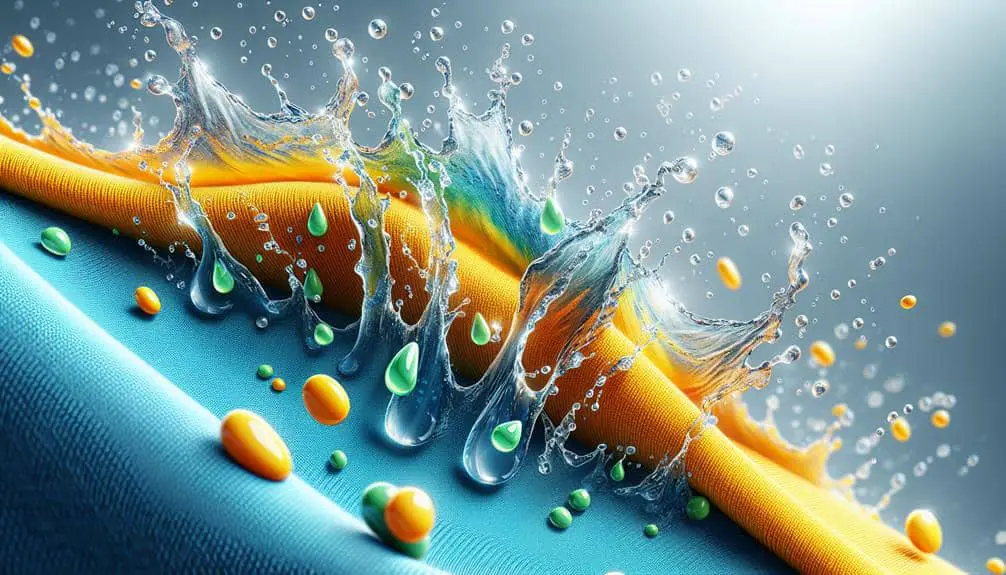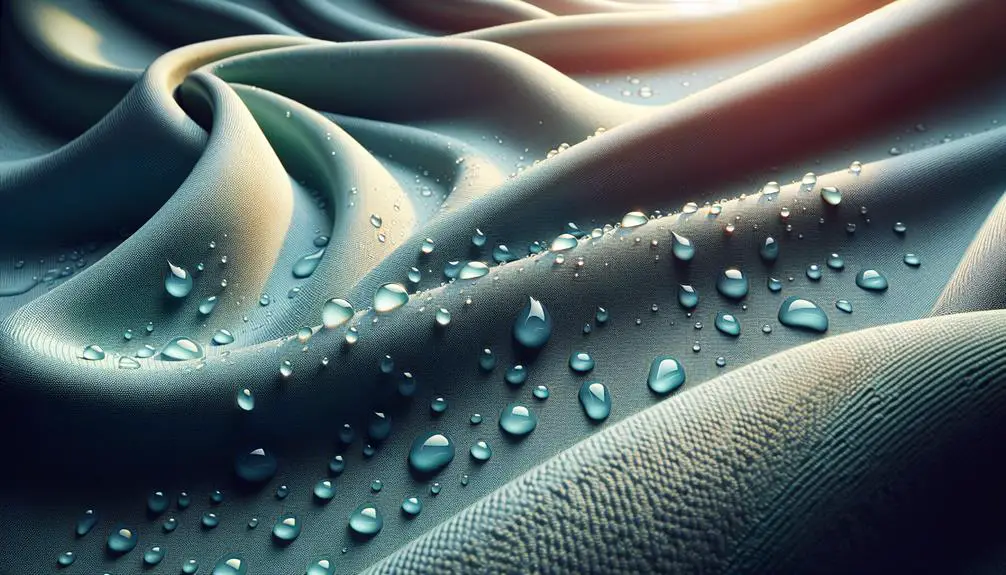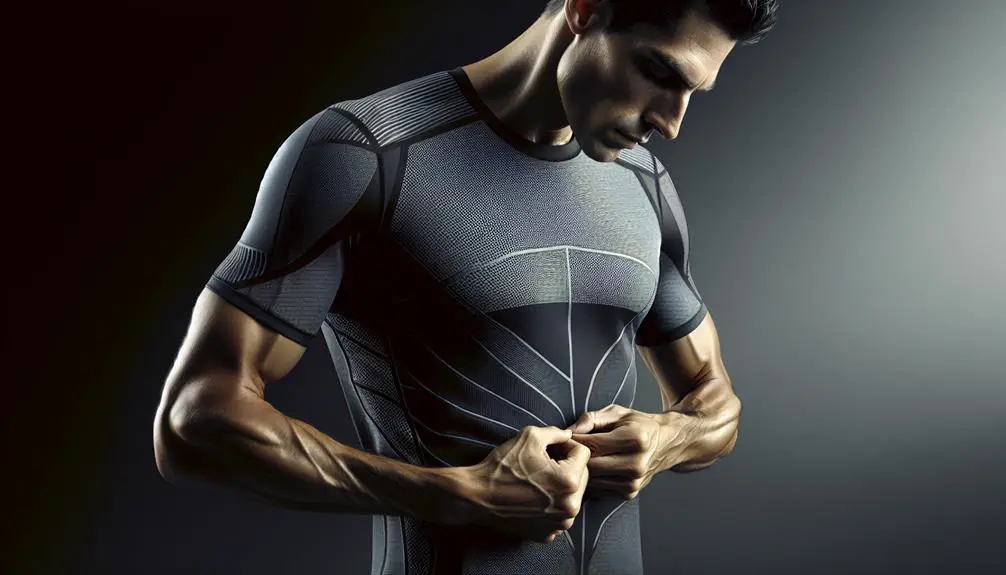Explore the science of moisture-wicking technology. Hydrophobic fibers like polyester and nylon repel moisture, ensuring strength and breathability. Capillary action within the fabric transports moisture efficiently through fine gaps. Evaporation cools your body during activities by taking away heat energy. Fabric structures impact moisture absorption, with weaving techniques enhancing evaporation. This technology effectively manages sweat, regulates body temperature, and enhances performance. Delve deeper into the intricate world of fabric science for a thorough understanding.
Key Points
- Hydrophobic fibers repel moisture, ensuring durability and breathability.
- Capillary action in fabric transports and spreads moisture efficiently.
- Evaporation process cools the body by removing heat through moisture.
- Fabric structure impacts moisture control and evaporation rate.
- Moisture-wicking technology manages sweat, regulates temperature, and enhances performance.
The Role of Hydrophobic Fibers
Hydrophobic fibers repel moisture due to their unique chemical properties, making them indispensable in moisture-wicking technology. These fibers, such as polyester and nylon, exhibit exceptional durability and breathability, key characteristics for efficient moisture management in fabrics.
Durability is an important aspect of hydrophobic fibers in moisture-wicking technology. These fibers possess strong molecular structures that resist wear and tear, ensuring the longevity of the fabric's performance. By maintaining their integrity even in harsh conditions, garments made from hydrophobic fibers can withstand frequent washing and intense physical activities without compromising their moisture-wicking abilities.
In addition to durability, the breathability of hydrophobic fibers plays a significant role in moisture management. The inherent structure of these fibers allows for enhanced air circulation within the fabric, aiding in the evaporation of moisture from the skin's surface. This breathability not only enhances comfort during physical exertion but also accelerates the drying process, keeping the wearer dry and cool in various environments.
Capillary Action in Fabric
Capillary action in fabric facilitates the movement of moisture through the material, aiding in efficient moisture transport and management. This phenomenon relies on the unique properties of the fabric's fibers. Specifically, the capillary action is enabled by the fine interstices present between individual fibers. These spaces create channels for liquid absorption to occur. The capillary effect within these channels allows moisture to be drawn along the fibers, spreading it across a larger surface area.
Fiber properties play a vital role in determining the effectiveness of capillary action. Fabrics with smaller gaps between fibers tend to exhibit stronger capillary action, enhancing their ability to wick moisture away from the body. Additionally, the composition of the fibers can impact their liquid absorption capacity. Hydrophilic fibers have a natural affinity for water, promoting capillary action and efficient moisture management.
Understanding how capillary action operates within fabric is essential for developing advanced moisture-wicking technologies that cater to the needs of individuals seeking high-performance apparel for various activities.
Evaporation for Heat Regulation
To optimize heat regulation in moisture-wicking fabrics, the process of transformation plays a key role in maintaining comfort during physical activities. When moisture from sweat or external sources comes into contact with the fabric, the evaporation process begins. This process involves the liquid water molecules changing into a gaseous state due to the heat generated by your body during exercise. As these water molecules evaporate, they take away a significant amount of heat energy from your skin, aiding in cooling your body and preventing overheating.
Temperature regulation through evaporation is vital for enhancing performance and comfort during workouts. By efficiently managing moisture through evaporation, moisture-wicking fabrics help maintain an ideal microclimate next to your skin, reducing the risk of discomfort and chafing. This evaporation process is essential for preventing the build-up of sweat on your skin, which can lead to increased body temperature and hinder your physical performance. Understanding how evaporation contributes to heat regulation is fundamental for appreciating the benefits of moisture-wicking technology in sportswear.
Fabric Structure for Moisture Control
Fabric structures in moisture-wicking technology play an essential role in controlling moisture absorption and retention. The design of the fabric directly impacts its ability to manage sweat effectively. Fabrics with improved breathability feature a structure that allows air to circulate, aiding in the evaporation of moisture. This enhanced breathability is achieved through various methods, such as using synthetic fibers that are engineered to have micro-gaps or utilizing weaving techniques that create open spaces within the fabric. These structural elements enable the fabric to pull moisture away from the skin and disperse it across a larger surface area, facilitating quicker evaporation.
Moreover, the fabric's composition influences its sweat absorption capacity. Fabrics designed for moisture control often incorporate hydrophilic properties, which attract and absorb sweat. By combining these properties with a suitable fabric structure, moisture-wicking garments can effectively manage perspiration during physical activity, keeping you dry and comfortable. Understanding the interplay between fabric structure and composition is vital in developing textiles that excel in moisture control.
Benefits of Moisture-Wicking Technology
The benefits of moisture-wicking technology lie in its ability to efficiently manage sweat during physical activities, enhancing comfort and performance for wearers. This technology works by pulling moisture away from the skin to the outer surface of the fabric where it can evaporate quickly.
Here are three key benefits of moisture-wicking technology:
- Sweat Management: By effectively wicking sweat away from your skin, moisture-wicking fabrics help regulate your body temperature during exercise, preventing discomfort caused by excessive sweat accumulation.
- Performance Enhancement: Moisture-wicking technology enables you to stay drier, lighter, and more comfortable during physical activities, allowing you to focus on your performance without being distracted by sweat-soaked clothing.
- Odor Control: By keeping moisture at bay, moisture-wicking fabrics also reduce the growth of odor-causing bacteria, keeping your activewear fresher for longer periods.
Frequently Asked Questions
How Does Moisture-Wicking Technology Compare to Other Types of Fabric Treatments for Moisture Management?
When comparing moisture-wicking technology to other fabric treatments for moisture management, fabric performance is superior. Sweat management is optimized through advanced moisture control methods, showcasing textile innovation at its finest. Discover the benefits of this cutting-edge technology today.
Are There Any Environmental Concerns Associated With the Production or Use of Moisture-Wicking Fabrics?
Environmental impact can vary with moisture-wicking fabrics. Some concerns include microfiber pollution, chemical usage in production, and energy-intensive manufacturing processes. Sustainability concerns focus on resource depletion, waste generation, and potential harm to ecosystems.
Can Moisture-Wicking Technology Be Applied to All Types of Clothing, or Are There Limitations to Its Effectiveness?
So, you're curious about the mighty moisture-wicking tech and its clothing conquests! Well, here's the scoop: while performance limitations exist based on fabric construction, this wizardry can enhance most garments. Dive deeper, fabric enthusiasts!
Is There a Recommended Care Process for Maintaining the Moisture-Wicking Properties of Fabric Over Time?
To maintain the fabric care and longevity of moisture-wicking properties, employ performance maintenance. Use specialized washing techniques, avoiding fabric softeners and high heat. Prioritize air drying to guarantee the efficacy of the moisture-wicking technology over time.
Are There Any Potential Health Benefits or Drawbacks to Wearing Moisture-Wicking Clothing on a Regular Basis?
Explore the world of moisture-wicking clothing. Uncover potential benefits such as moisture control and comfort, but be mindful of possible drawbacks like skin irritation due to trapped moisture or sensitivities to certain materials.


